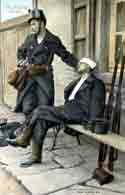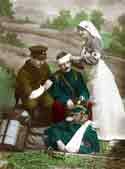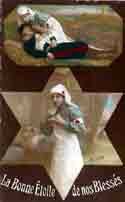Belgian's Scattered Army Reassembled
In the first month of the war the Belgian army became scattered, but it gradually reassembled.
This American picture shows them landing at Zeebrugge harbor.
![]() Click on one of the small photo's below - and you'll get the full picture.
Click on one of the small photo's below - and you'll get the full picture.
 |
Belgian War Dogs
Belgium was the only European country that used dogs to draw mitrailleuses. |
|
 |
Ready for the Enemy
Belgian armored motor cars. The car on the left carries a machine gun. The one on the right is simply armored with sheet steel to stand heavy fire. |
|
 |
War Cemetery
A War Cemetery in the Belgian village of Woesten. |
|
 |
Occupation Force in Brussels
Prussian Hussars in the Belgian capital of Brussels. |
|
 |
Wounded Belgian Soldier
Belgian soldier standing by a wounded comrade. |
|
 |
Crack Austrian Infantry
Austrian soldiers from Vienna parade. The long trousers worn by these troops show that they are recruited from the Germanic part of the empire, but for the Austrian army. |
|
 |
Rough Riders of Russia
The Cossacks of the river Don area pay no taxes, but are liable to military service from 18 to 50 and each must furnish his own horse. |
|
 |
Marching with Long Bayonets
Russian regulars on the march trough Galicia. |
|
 |
Russian Steam Roller
The Russian Grenadiers of the Guard, the Czar's crack regiments. |
|
 |
Indian Troops
Immediately after the beginning of the war England shipped 70,000 native troops from India to Europe. |
|
 |
Death's Head
The Prussian Crown Prince's Regiment. |
|
 |
The New German Siege Gun
The Surprise of the War: these German siege guns that battered Namur into ruins, reduced Meubeuge and were employed in the capture of Antwerp. |
|
 |
Protege
French picture, 1915, obviously faked. |
|
 |
Courage
Another picture from the same French series. |
|
 |
La Bonne Etoile
From a similar French series. |
|
 |
Ruins of Senlis
Before Rheims, Senlis (Northern France) was razed to the ground by the German army. |
|
 |
Taking the war to the pyramids
New Zealanders on camels in Egypt. |
|
 |
Uhlans on Watch
German Uhlans on the lookout. |
|
 |
French 75's
'Notre 75 en action', is the original caption on this French picture. |
|
 |
On the Move
'French soldiers moving on the enemy's flank', is what the photographer of the Underwood & Underwood Agency wrote down on this picture. |
|
 |
Refugees
Peasants fleeing from the city of Louvain on hearing of the approach of German forces. |
![]() Click on a number for the other pages with color pictures: 0 - 1 - 2 - 3 - 4 - 5 - 6 - 7 - 8 - 9
Click on a number for the other pages with color pictures: 0 - 1 - 2 - 3 - 4 - 5 - 6 - 7 - 8 - 9
![]() Or go straight to the frontpage of The Heritage of the Great War
Or go straight to the frontpage of The Heritage of the Great War
Sources: Most of the pictures above come from our own collection. Others were found in books, and a few elsewhere on the Internet - RR.